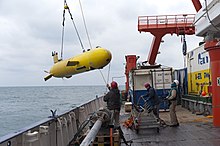Autonomous underwater vehicle
Autonomous underwater vehicles (in specialist literature also AUVs , from English autonomous underwater vehicles ) belong to the category of unmanned underwater vehicles and carry out tasks in the sea autonomously.
Areas of application
Areas of application for AUVs are, for example, the oil and gas industry uses them offshore to create detailed bathymetric maps of a terrain before subsea infrastructure is installed. They are also used for cable and pipeline inspection. The most common military application of AUVs is marine mine detection and defense. AUVs are also used in oceanographic research to e.g. B. to collect bathymetric data, to detect methane deposits and to find hydrothermal sources in the deep sea .
Technical requirements
Autonomous diving robots are generally torpedo-shaped and powered by a propeller at the stern. In contrast to remote-controlled underwater vehicles ( ROVs ), they work completely independently, i.e. independently of the carrier ship and without cables. Today AUVs are built that can reach a water depth of up to 6000 m. The dive times range from hours and days to several months in a row with glider AUVs . AUVs require little technical and logistical support in the course of their use . You can work in regions that cannot be reached by a manned submersible or ROV, such as ice areas.
The autonomous operation of AUVs results in special technical challenges:
- The power supply for the drive, vehicle sensors and payload components must be ensured. All of the electrical energy required for an operation must be transported on board the vehicle. To date, batteries and accumulators have been used for this purpose, but fuel cells and air-independent diesel engines (closed cycle diesel engines) are also used.
- AUVs require sophisticated control software so that they can make decisions autonomously. For example, they have to recognize obstacles on their route and avoid them or react appropriately to technical problems such as failed sensors .
- Communication - even in the event of a fault - is hardly possible with AUVs, since radio signals are strongly absorbed by the water, so appropriate emergency protocols must be set up. Since they cannot appear under polar ice in the event of a fault, AUVs are relatively often lost on corresponding missions.
Research and Development
AUVs are currently the subject of some research projects that deal with the central problems of vehicles. Important points are the miniaturization of the vehicles, simultaneous localization and cartography , which can be regarded as solved in the two-dimensional case, but is considered to be an unsolved problem in three-dimensional underwater environments, and autonomous decision-making.
There are some publicly funded projects that want to advance work on these problems in the form of student competitions. Examples of this are the SAUC-E jointly organized by the English and French defense ministries (especially the Dstl ) or the International Autonomous Underwater Vehicle Competition organized by AUVSI and the ONR . These competitions have prizes of tens of thousands of euros or dollars.
See also
literature
- Gwyn Griffiths: Technology and Applications of Autonomous Underwater Vehicles. Taylor & Francis, London 2002, ISBN 978-0-415-30154-1 .
- Gianluca Antonelli: Underwater robots - motion and force control of vehicle-manipulator systems. Springer, Berlin 2006, ISBN 978-3-540-31752-4 .
- Rajendra Jani: Development of an autonomous underwater vehicle - Hydrocopter. Vdm Verlag, Saarbrücken 2009, ISBN 978-3-639-09644-6 .
- Ian Kemp, et al .: Unmanned Vehicles Handbook 2009 . The Shephard Press, Slough 2008, ISBN 978-1-9074-5404-2 .
- Nathaniel Fairfield, (et al.): Field Results of the Control, Navigation, and Mapping Systems of a Hovering AUV. Intl. Symp. On Unmanned Untethered Submersible Technology, 2007 Abstract online (PDF)
Web links
- Autonomous Undersea Vehicle Applications Center
- Presentation of the AUV Abyss of the IFM-Geomar in Kiel (German)
- Introduction to the AUV B-Seal of the Marum in Bremen (German)
Individual evidence
- ^ Alfred Wegener Institute for Polar and Marine Research
- ↑ Underwater robot crosses the Atlantic science.orf.at; Unmanned research sub crosses Atlantic CNN, accessed December 11, 2009.
- ↑ AUV MARUM-SEAL marum.de, accessed on October 16, 2011
- ↑ Thomas Wilke: Torpedo with a sharp eye. Pp. 43–45, in: Bild der Wissenschaft 10/2011, ISSN 0006-2375


